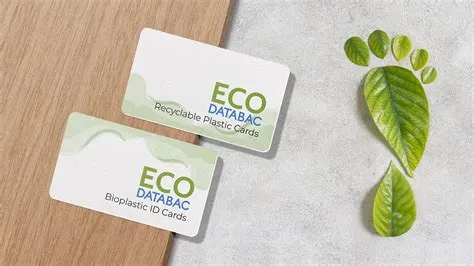Hey there, business owners and design enthusiasts! Ever stopped to think about your humble employee ID card? It’s more than just a piece of plastic; it’s a mini-billboard for your brand, a symbol of belonging, and a key to access. And with trends constantly evolving, it’s time to ditch the boring, outdated designs and embrace the exciting possibilities of innovative ID card design. We’re diving deep into the latest trends, focusing on how to create ID cards that are both stunning and sustainable.
Let’s face it, a well-designed ID card makes a statement. It reflects your company culture, professionalism, and even your commitment to the environment. So, how do you balance style and sustainability? It’s easier than you think!
The Rise of Minimalism: Remember those overly busy ID cards from the past, crammed with information and logos? They’re out! Minimalist designs are in. Think clean lines, bold typography, and a focus on a few key elements. This approach isn’t just visually appealing; it also makes the card easier to read and less likely to feel overwhelming. It’s about quality over quantity, making each element count. Think of it like a well-curated wardrobe – less is often more.
Branding Powerhouse: Your ID card is prime real estate for showcasing your brand. It’s a walking, talking advertisement! Consistent branding across your ID cards, stationery, and marketing materials creates a cohesive brand identity, strengthening brand recognition and reinforcing your company’s message. This means incorporating your brand colors, fonts, and logo in a stylish and subtle way. Don’t just slap your logo on – integrate it thoughtfully. Imagine your ID card as a miniature version of your company’s website or storefront; it should reflect the essence of your brand.
Sustainable Materials: The Eco-Conscious Choice: Now, let’s talk about something vitally important: sustainability. Using eco-friendly materials in your ID card production is not only good for the planet but also aligns with growing consumer preferences. More and more businesses are prioritizing environmentally conscious practices, and your ID card can be a reflection of that. Choosing recycled materials or plant-based options like bamboo demonstrates your company’s commitment to responsible business practices. Learn more about eco-friendly ID card materials to make a positive impact.
Smart Cards: Embracing Technology: Technology isn’t just for smartphones anymore. Smart cards, which incorporate microchips, are becoming increasingly popular for their enhanced security and functionality. They can store additional information, facilitate access control, and even act as payment cards. This added functionality makes smart cards a versatile and future-proof choice. Check out our blog on technology-integrated ID cards to see the amazing possibilities!
Industry-Specific Designs: Tailoring to Your Needs: Just as your business is unique, your ID card should reflect that uniqueness. Industry-specific designs allow you to incorporate elements relevant to your sector, creating a more professional and impactful card. For example, a healthcare provider might include a medical symbol, while a tech company might opt for a sleek, modern design. Explore more ideas on industry-specific ID card designs and discover how to create a card that truly resonates with your field. You can also find inspiration on our blog about modern ID card design ideas and even learn more about design trends in industry-specific ID cards.
Personalization: Making it Personal: While branding is crucial, personalization adds a human touch. Allowing employees to personalize their cards within the brand guidelines fosters a sense of ownership and pride. This could include adding a personal photo or a subtle decorative element. It’s a simple yet effective way to boost employee morale and create a more welcoming atmosphere. Read more about customization and personalization in ID card design to inspire your unique ideas!
Beyond the Physical: Digital ID Cards: In today’s digital world, it’s essential to consider the digital counterpart to your physical ID card. Digital ID cards offer convenience and accessibility, allowing employees to access building entrances, company intranets, and other resources remotely. This seamless integration of physical and digital solutions is a key trend in ID card design. For more insights about the digital side of things, explore our resources on digital and virtual ID cards and digital ID trends.
Sustainable Production Methods: Minimizing Your Environmental Footprint: Don’t forget the environmental impact of your ID card production! Opting for sustainable printing techniques and sourcing materials responsibly minimizes your carbon footprint. This not only reflects your values but can also improve your company’s reputation. This commitment extends to the entire lifecycle of the card, from design and production to eventual disposal. Choosing recycled materials and eco-friendly inks are vital aspects of sustainable ID card production. Discover more on our blog about sustainable ID card production methods and delve deeper into the details about eco-friendly printing techniques and sustainable ID card materials. We also provide information regarding eco-friendly business solutions.
Security Features: Protecting Your Business: Protecting your business from unauthorized access is paramount. Incorporating advanced security features into your ID cards, such as holograms, watermarks, and UV printing, adds an extra layer of protection. These features deter counterfeiting and help maintain the integrity of your security systems. This element goes hand-in-hand with the functionality of your card – a balance that requires careful design. Learn more about the security aspects in our resources on security and access control, security and access solutions, and sustainable and eco-friendly tech.
The Future of ID Cards: The evolution of ID card design isn’t slowing down. We can expect to see even more innovative features, such as embedded sensors and biometric authentication, integrated into future designs. The line between physical and digital cards will continue to blur, leading to more seamless and integrated solutions. But remember, even with technological advancements, the core principles of good design – simplicity, functionality, and sustainability – will always remain essential.
Conclusion:
Designing an ID card isn’t just about aesthetics; it’s about crafting a powerful tool that reflects your brand, enhances security, and aligns with your company values. By embracing the latest trends in design and prioritizing sustainability, you can create ID cards that are both visually stunning and environmentally responsible. Don’t settle for a boring, outdated card; invest in a design that makes a statement. It’s an investment in your brand and a commitment to the future.
FAQs:
1. What are the most sustainable materials for ID cards? Recycled PVC, plant-based plastics (like those made from bamboo or corn), and other biodegradable materials are excellent sustainable options.
2. How can I ensure my ID card design is both secure and aesthetically pleasing? Incorporate subtle security features, like watermarks or UV printing, into a minimalist or branded design. Don’t let security compromise your style.
3. What are the benefits of using smart cards? Smart cards offer increased security, enhanced functionality (like access control and payment capabilities), and provide a more versatile solution for your business needs.
4. How do I balance branding and personalization on employee ID cards? Establish clear brand guidelines (colors, fonts, logo placement) and allow for limited personalization, such as employee photos or subtle decorative elements.
5. Where can I find more information on sustainable ID card production? Explore our blog for detailed resources and best practices on eco-friendly materials, printing methods, and sustainable design choices. Remember to check out our comprehensive blog at amazing.biz.id/blog for more tips and tricks!

